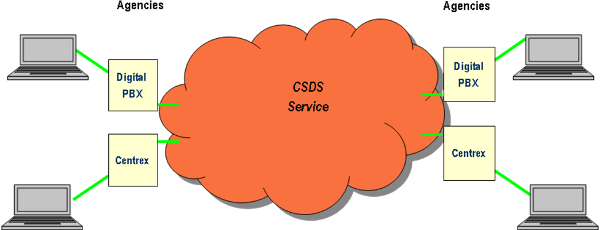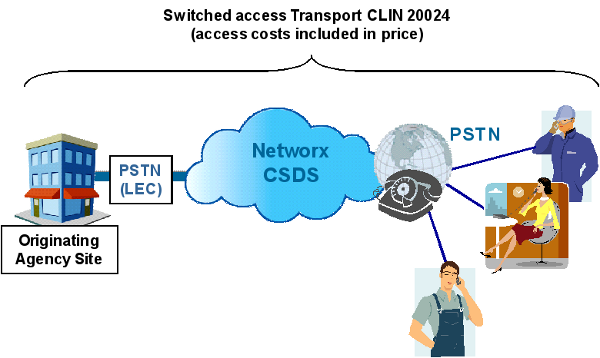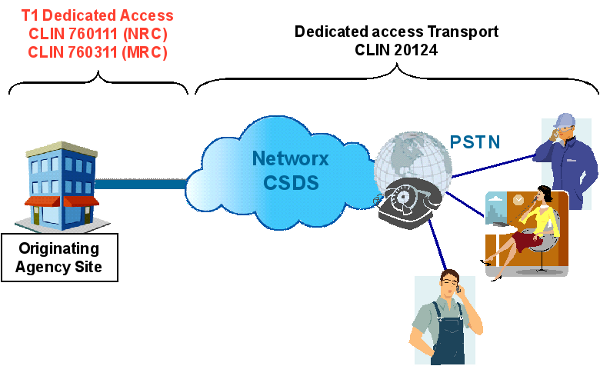CSDS is a mature switched data service provided by GSA in previous local and long distance telecommunications contracts. Some Agencies continue to use CSDS, particularly in the area of on-demand video conferencing applications.
CSDS provides a synchronous, full duplex, totally digital, circuit switched data connection at data rates from DS0 to DS1, including integral multiples of DS0 data rates (i.e., NxDS0, where N = 1 to 24) to on-net and off-net locations for compressed video conferencing and as a backup circuit for a dedicated circuit.
CSDS calls can be initiated from Government-specified terminals, such as digital PBX, Intelligent MUX, Group 4 FAX, Video codec, and Workstation/PC.
CSDS is interoperable with the Public Switched Telephone Network (PSTN) and all Networx CSDS contractors' networks. The figure below illustrates CSDS connectivity from on-net locations, such as Agencies served by Digital-PBXs and Centrex Central Offices.

Example of CSDS Connectivity
CSDS supports the full range of technical capabilities that are available in commercial offerings. These capabilities include:
These and other service capabilities are detailed in Section C.2.2.2.1.4 Technical Capabilities of the Networx contracts.
CSDS also offer features that complement the basic service. These features are described in Section C.2.2.2.2 Features of the Networx contracts:
* The optional User-to-User Signaling Via ISDN D-Channel feature may not be provided by all Networx contractors.
CSDS is similar to the Circuit Switched Data Service offering on the FTS2001 contracts.
Each Networx contractor may provide variations or alternatives to the offering and pricing for CSDS. The specific details can be found within each contractor's Networx contract and pricing notes for CSDS.
For more information on the general CSDS specifications and requirements, please refer to Section C.2.2.2 of the Networx contract for technical specifications and Section B.2.2.2 for pricing.
CSDS provides a synchronous, full duplex, totally digital, circuit switched data connection to on-net and off-net locations for compressed video conferencing and as a backup circuit for a dedicated circuit. CSDS provides circuit switched service at data rates up to DS1, including integral multiples of DS0 data rates (i.e., NxDS0, where N = 1 to 24) to on-net and off-net locations. Calls can be either:
AT&T, MCI, and Sprint can integrate VS and CSDS traffic on the same dedicated access arrangement CLIN--a capability that was available on the FTS2001 contracts. Qwest also provides this capability but for only the CSDS CLINs with "Single PRI" in the CLIN descriptions (see CLINs 20150 - 20173). Integrating VS and CSDS traffic may reduce costs by reducing the number of required access arrangements. There is no contract requirement to integrate VS and CSDS traffic on the same dedicated access arrangement.
CSDS provides a similar capability to FTS2001 Circuit Switched Data Service.
Price components required for full end-to-end service for CSDS:
Example 1: T1 CSDS with Switched Access Origination

Example 2: T1 CSDS with Dedicated Access Origination

Each Networx contractor may provide variations or alternatives to the offering and pricing for CSDS. The specific details can be found within each contractor's Networx contract files and pricing notes for CSDS.
For more information on the general CSDS specifications and requirements, please refer to Section C.2.2.2 of the Networx contract for technical specifications and Section B.2.2.2 for pricing.